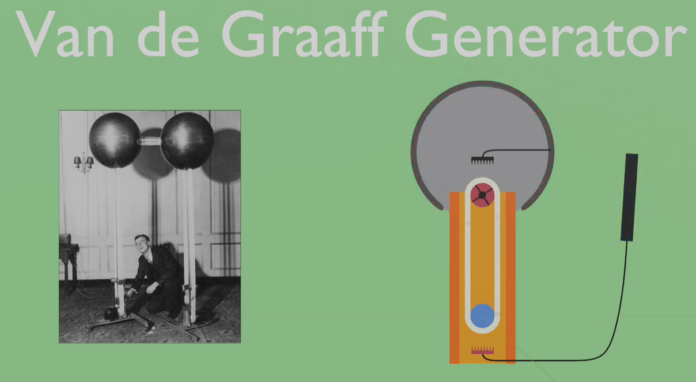Introduction
Physics has several wonders in the world. Most of them continue to surprise us even today. Do you know who the brightest physicists of their time were? Yes, those whose hunger to know more was never satisfied. Ranging from Tubelight to Mobile phones, everything invented by them has been a boon to us till now. These curious gems have stamped up their names in the golden pages of history. We salute them for the mesmerizing work they did. One such wonder is the Van De Graaff Generator. It was also invented by a bright physicist, whom we’ll discuss further in this article. For now, let’s quickly understand what this generator is without further delay.
History
Dr. Robert J Van De Graaff, a professor at the Massachusetts Institute of Technology (MIT), USA, invented the Van De Graff Generator in 1931. De Graaff invented this device to facilitate experiments in nuclear physics. He wanted to generate high voltages with the help of this Van De Graaff Generator so that they could be used in the experiments.
History suggests that he invented this largest air-insulated generator to help in atom-related research and experiments with X-rays. Later, new methods were adopted for such purposes. So this generator was being used for educational purposes.
Nowadays, schools and other institutions are demonstrating it to enlighten them.
What is Van De Graaff Generator?
It is an electrostatic machine that is capable of generating high voltage. It has an insulator belt and a terminal. Electrical charges travel through this belt to the airport. These charges are a by-product of a direct current of very high voltage.
The charges are received by the terminal and transferred to its outer exterior from there. You must have understood by now that it can serve the purpose of an insulator. It helps other bodies get insulated through this effect.
Working Principle of Van De Graaff Generator
You can see the description of the generator below.
It consists of a vast metallic sphere as you can see at the topmost region. The sphere is generally hollow or weightless. The globe is placed over two insulating pillars that are supported by the pulleys.
The pillars run over two pulleys marked 1 and 2. A white belt (flexible) runs over the pulleys in the Van De Graaff Generator with the help of a motor.
There are two conductors, namely the upper comb and the lower comb. The lower one is connected to a high voltage curator labeled as 6. The upper one is connected to the sphere.
If we put a charge of magnitude x on the hollow sphere, it’ll spread evenly over its surface. Hence, the electric field inside it becomes 0. Hence, the inside of the sphere is constant and the outside is a point charge.
Let’s further study its functioning and derivation.
Functioning of Van De Graaff Generator
Let there be a sphere of radius R. Place a charge of magnitude Q over the sphere. See that the charge has spread uniformly over its surface. The electric field inside becomes equal to 0. The outside of the sphere is the outcome of q at the center.
Let us place a sphere smaller than that of radius R. Now, the charge on the smaller one is q. Hence, the center of the smaller sphere can be represented as
Now, the large sphere looks like
The total number of charges becomes (Q+q) now. Substituting the same values, we get
Uses of Van De Graaff Generator
Though its implications have been limited to educational purposes only, it has some basic uses, such as the following.
- For the generation of very high voltage, as we previously discussed.
- Academically, it’s being used for the practical demonstration of the electrostatic behavior of particles.
- Physicists also use it as a medium to study collision experiments
- Doctors take their help in the treatment of cancer patients as their rays serve medicinal purposes.
- It helps in the study of nuclear physics and, thus, is one of the most popular generators in history.
- It helps in food processing by accelerating the electrons, which sterilizes the food.
Recommended Articles:
Vector Product of Two Vectors
Understanding Vector Velocity and Their Components
Venus – Characteristics, Geology and Facts
Volcano Eruption: The Science Behind Volcanic Eruptions
What is Vt Graphs? Definition, Case and Formula
It is an electrostatic generator capable of producing very high voltages. It was founded in the USA. Its belts have the capability of producing very high insulation. It has various academic uses as well. It has multiple uses, such as in food processing, educational purposes, practical demonstration of electrostatic forces, etc. It can also be used to study collision experiments. Its most important implication is that it helps in the study of nuclear physics. It consists of a hollow metallic sphere, lower roller, upper roller, Dome, ground, upper comb, two pulleys, and lower comb. The lower comb is connected to a very high-voltage motor. Also, the sphere is placed over two insulating belts. It was founded by Dr. Robert J. Van De Graaff, who was a professor at the Massachusetts University of the United States of America. His sole purpose behind the invention was a very high-generation current that can be used in nuclear physics. Van De Graaff Generator FAQs
What is a Van De Graaff Generator?
What are its various implications?
What is its structure like?
Who is the inventor of this generator?
